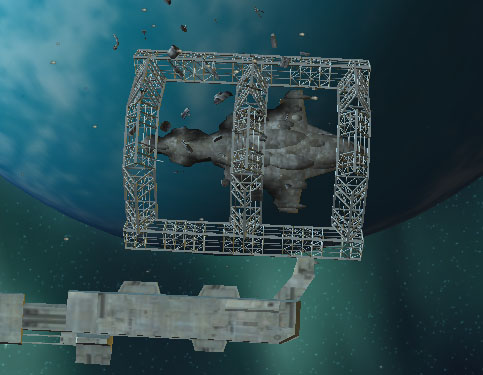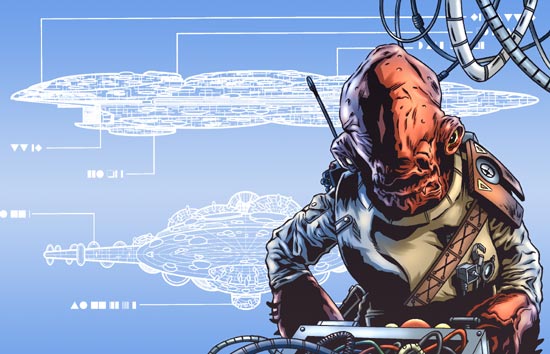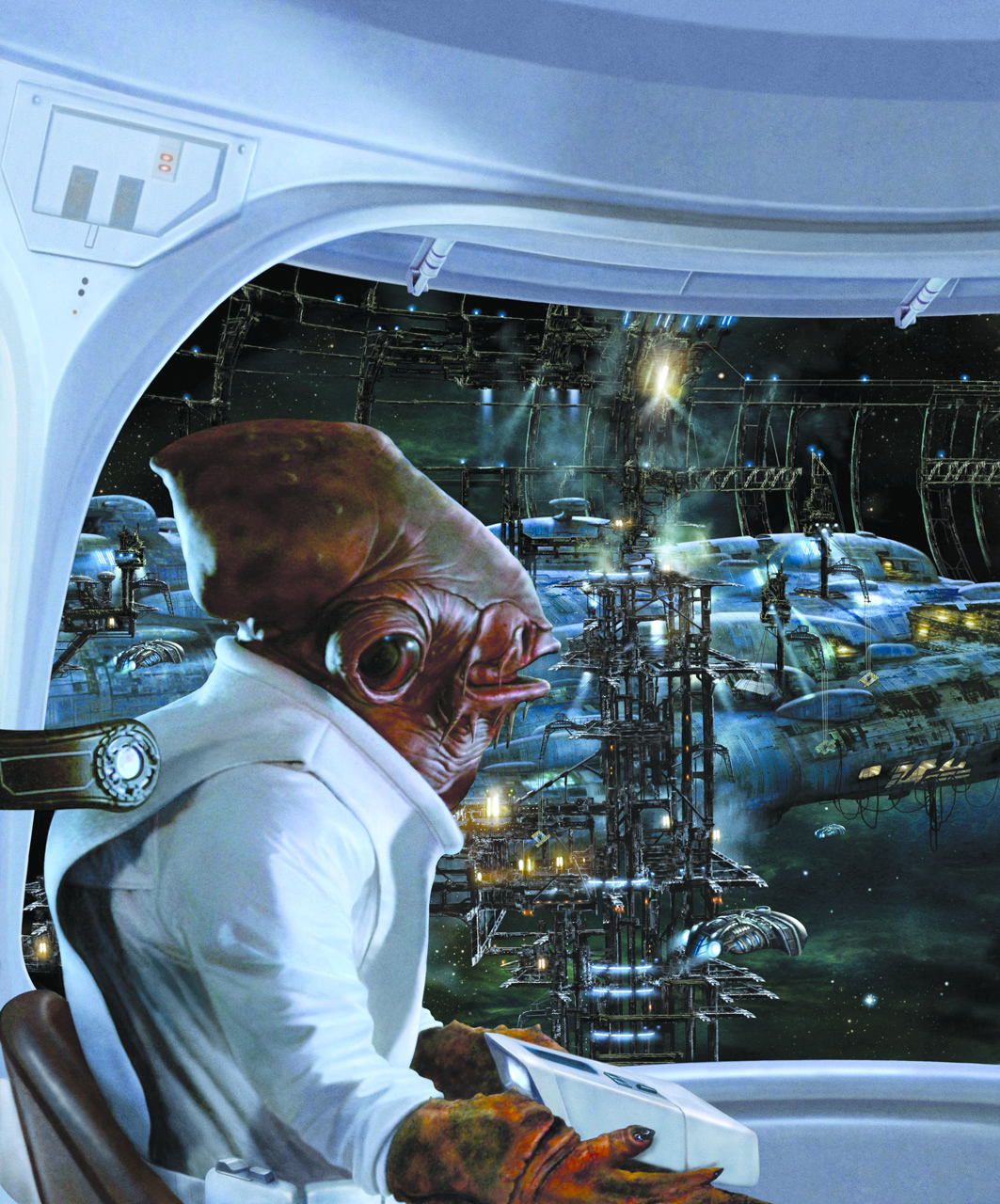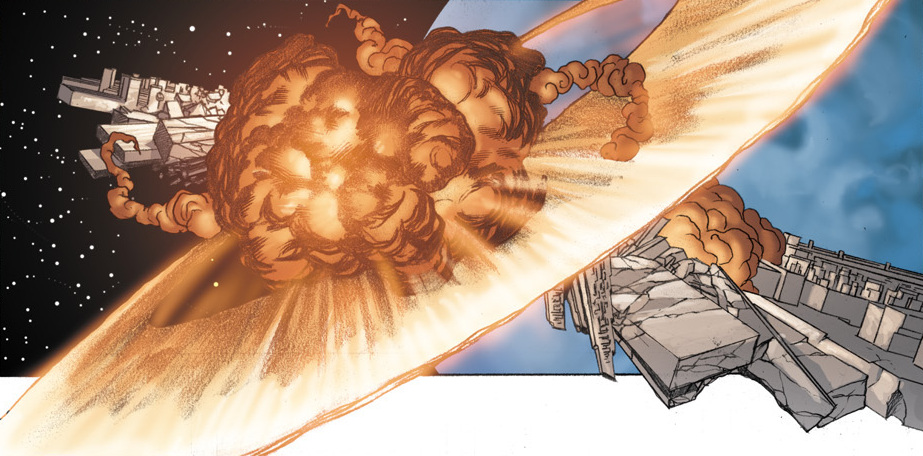The starship yards of Dac were built thousands of years before the fall of the Galactic Republic but they acquired galactic renown during the Galactic Civil War by producing elegant and powerful capital warships for the Alliance to Restore the Republic, and later for the New Republic. The size and productivity of the Mon Calamari Shipyards increased so much under the New Republic that they had became one of the largest shipyards of the galaxy at the time of the Galactic Alliance. However, the fame of the shipyards eventually led to their doom. A large portion of the Mon Calamari Orbital Shipyards were destroyed during the Second Imperial Civil War and the remaining facilities were abandoned as the entire population of Dac was slaughtered by the One Sith.
The Mon Calamari Shipyards were immense orbital starship-construction facilities which surrounded and circled Dac, an aquatic planet located in the Calamari sector of the Outer Rim Territories. The Mon Calamari Orbital Shipyards were one of the most important shipyards in the galaxy and the pride of the sector. The shipyards of Dac had been built conjointly by the Mon Calamari and the Quarren, the two native sentient species. The former were a spacefaring species who considered shipbuilding to be an art form, while the latter were skilled artisans and miners, though they did not share the Mon Cal enthusiasm for space travel. Hence, millions of Mon Calamari engineers and shipwrights collaborated routinely with Quarren shipbuilders in the yards. The Mon Calamari shipwrights formed altogether a shipwright company known simply as the Mon Calamari Shipyards.

A shipyard above Dac.
The shipyards of Dac encompassed numerous zero-g construction yards, orbital dry docks and starship space dock hangars, each serving as a central hub around which hovered supply platforms, girder impellers, work shuttles and crablike constructor pods. Such orbital stations included Rendili StarDrive's Orbital Construction Docks. The Mon Calamari Shipyards were considered as sophisticated as the yards of Fondor and Gyndine. They could manufacture any kind of starships from small starfighters to massive Star Cruisers. These shipyards were specifically conceived to produce vessels of Mon Calamari design. These vessels were widely reputed for their high quality and for their elegance. Nevertheless, the shipyards were poorly adaptable to other starship systems, even the most basic galactic standards.
The majority of raw materials used in the shipyards were provided by a nearby asteroid belt. Ores were also mined from Dac's ocean floor. The city of Morjanssik was established to mine farium metal in a deep trench in the oceans of Dac. In addition, plasteel was provided from Dac's moon or shipped from other systems. Most of the mining operations supplying the shipyards, either undersea or in space, were performed by the Quarren.
The security of the shipyards was maintained by the Shipyard Security Corps.
The shipyards of Mon Calamari came into being over four thousand years before the Battle of Yavin. The Mon Calamari and the Quarren together constructed several orbital facilities, which were used to study techniques ranging from zero-gravity manufacturing to starship propulsion. Thus began the first construction of starliners which explored first the Calamari system and later surrounding worlds, including Ruisto and Mantan, which were eventually colonized. The Quarren also established asteroid mining operations to supply Mon Calamari with additional resources. In time, Dac became encircled with shipyards and construction facilities.
In 4166 BBY, Mon Calamari starliners stumbled across Galactic Republic exploration vessels. Despite the level of advanced technology that they discovered, Republic explorers did not fully grasp the ability of the world's shipyards. For centuries, Mon Calamari designs were seldom seen outside the Calamari sector and the shipyards remained rumors to much of the galaxy.
Nevertheless, towards the end of the Republic, the Mon Calamari shipyards became a key affiliate of Rendili StarDrive, therefore producing variants of the Dreadnaught-class heavy cruiser alongside their native vessels.
Near the end of the Republic, the Mon Calamari Orbital Shipyards came to the attention of Count Dooku the leader of the Confederacy of Independent Systems. As the Separatist movement grew, Count Dooku visited Dac. Upon seeing the vessels that they were able to build, Dooku judged the shipyards highly advanced and sophisticated. Yet, when Dooku tried to recruit Dac and its shipyards to join his growing movement, but the Mon Calamari Council refused. Angered, Dooku unleashed the Force Harvester superweapon on the world in 22 BBY, which severely damaged its shipyards and killed millions.

A Mon Calamari with plans for a cruiser
Despite this tragedy, The planet Dac and its inhabitants remained embroiled in the Clone Wars until the end of the conflict. During the War, the Calamari sector was divided between the Mon Calamari loyal to the Republic and the Quarren who had joined the CIS, founding the Quarren Isolation League. These pro-Separatist Quarren made several attempts to "liberate" the Mon Calamari shipyards. Exiled Quarren shipwrights formed the Free Dac Volunteers Engineering Corps, based on the colony world of Pammant, and revised the Rendili Dreadnaught into the Providence-class carrier/destroyer for the Confederate Navy. In 21 BBY, the Seaparatits slicers succeeded in infiltrating the Mon Calamari shipyards and stole Mon Calamari warship plans.
The rise of the Galactic Empire brought enslavement and subjugation to Dac, led by Moff Wilhuff Tarkin. The shipyards became a valuable prize for the Empire, which wanted them for maintaining control over the neighboring Tion worlds and the outlying planets of the Perlemian Trade Route. Likewise, Tarkin attempted to retool the shipyards for Imperial use. This dream never fully materialized, as Imperial engineers struggled to adapt Mon Calamari tools and equipment. This was an impossible task, as everything from smelting techniques to arcfusers were designed for Mon Cal and Quarren physiology. After a few failed experiments in using the yards to build warships for the Empire, the project was scrapped when the Imperial High Command deemed it too expensive. Finally, the Empire delegated control of the shipyards to the Loronar Corporation to produce Strike-class cruisers for the Imperial Navy. In addition, Tarkin, because of his admiration of the elegant winged hullforms of the new MC80 cruisers, allowed the Mon Calamari to build variants of the vessels as luxury starliners for Galaxy Tours and . The Mon Cal shipwrights later repaid him by developing every component of these new liners as a prototype for future warships.

Admiral Ackbar observes the shipyards
In 1 BBY, during the Galactic Civil War, the Mon Calamari and the Quarren managed to overthrow their Imperial oppressors. The victory Mon Calamari became a beacon of hope to other planets, and a formidable force of Rebel warships moved into the Calamari system to aid in the defense of the planet and its shipyards. The Mon Calamari joined the Rebel Alliance and the Mon Calamari Starship Construction Facilities became the first and only shipyard able to produce capital ships for the Rebellion. The shipyards began to modify their massive starliners into combat-capable warships and began to build new models of more powerful cruisers. The Mon Calamari Star Cruisers became the backbone of the Alliance Fleet, led by Mon Calamari Admiral Ackbar. Thanks to the dedicated Mon Calamari workers, the yards were capable to produce one corvette or one frigate by month, or one cruiser every six months. By the time of the Battle of Endor, the Mon Calamari Shipyards had produced eight new MC80 cruisers and nearly 50 escort ships, an achievement considering that a large part of the shipyard resources were used for starfighter construction.
In 3 ABY, the Shipyard Security Corps intervened in Docking Facility 7K to prevent the traitorous Alliance technician Ral Shawgrim to defect to the Galactic Empire with sensitive data on the X-wing starfighter.
After the Battle of Endor, the Rebel Alliance transitioned into the New Republic. The Mon Calamari Shipyards remained a major builder of warships. Thanks to the massive New Republic funding, the shipyards doubled their production every year, eventually reaching five percent of the entire New Republic budget. In response, the Mon Calamari shipwrights designed increasingly powerful battleships for the New Republic Defense Fleet.
In 10 ABY, the Mon Calamari Orbital Shipyards suffered heavy damage during the assault of the Empire's fearsome World Devastators. Nearly all the ships in the docks, but the MC90 Star Cruiser Startide, were destroyed. One year later, the shipyards were targeted by Imperial Admiral Daala. Although the Calamari Defense Force was lured into leaving the shipyards undefended to protect Reef Home City, the yards were saved from destruction by Admiral Ackbar.
At the time of the Corellian Crisis in 18 ABY, a large part of the New Republic Defense Fleet had been dispatched to the Mon Calamari Shipyards for repairs.
The shipyards were a key resource for the New Republic during the Yuuzhan Vong War. The yards continued to produce powerful warships as the New Republic military beefed up in response to the invasion. Even after being cut off from the rest of the New Republic when the Yuuzhan Vong pierced the Perlemian Trade Route, the shipyards kept up production, sending new units to the front lines via secret hyperspace routes.
Following the Fall of Coruscant, Dac and its shipyards became a even more vital asset as the government relocated to the water world. As the New Republic began to reorganize into the Galactic Alliance, the shipyards worked at a feverish pace to replenish and replace losses sustained earlier in the war. In the last stages of the war, the Mon Calamari and their shipyards were hailed as a symbol of idealism and determination in the face of danger. With most of the major shipbuilding worlds of the galaxy under Yuuzhan Vong control, the Mon Calamari shipyards were one of the most important manufacturing asset to the Galactic Alliance.

The Mon Calamari Shipyards in 137 ABY.
By the time of the Second Imperial Civil War, the Mon Calamari Orbital Shipyards had grown as a ring of connected space stations large enough to completely encircle the planet, much like the Kuat Drive Yards Orbital Array. After the defeat of the Galactic Alliance during the Sith–Imperial War, the Mon Calamari system and its shipyards fell to Darth Krayt's new Galactic Empire. The shipyards were entirely converted to produce Imperial military vessels, becoming one the primary sources of Imperial Star Destroyers. Moreover, Mon Calamari engineers were forced to improve Imperial warship designs, resulting in the development of the Imperious-class Star Destroyer.

One third of the Mon Calamari shipyards is destroyed.
In 137 ABY, the first prototype of Imperious-class Star Destroyer, the Imperious, was nearing completion in the Mon Calamari Shipyards. There, it was used as a a bait by the Empire to lure the Galactic Alliance Remnant into a trap and destroy Admiral Gar Stazi's main Alliance fleet. But the trap was unveiled by the Alliance before the battle. The Alliance Fleet and the shipyard's defense system (which had been hacked by Rogue Squadron) devastated the Imperial Outer Rim Third Fleet. Meanwhile, a group of stormtroopers, who were actually Alliance troops under the command of the ex-stormtrooper Hondo Karr, seized the Imperious. As the battle ended, the shipyards were devastated when Captain Jaius Yorub rammed the Alliance flagship Indomitable into them, destroying a third of the yards and damaging another quarter. The stolen Imperious was successfully delivered to one of the Remnant's bases.
In retaliation for the loss of the Imperious and the Mon Calamari Shipyards, Darth Krayt ordered the massacre of the entire population of Dac. Furthermore, the shipyards were closed as Mon Calamari shipwrights were among the victims of the genocide.

Remnants of the Mon Calamari Shipyards in 138 ABY.
Following the defeat of the Darth Krayt's Galactic Empire and the One Sith, in 138 ABY, the remnants of the abandoned Mon Calamari Orbital Shipyards were taken over by a pirate syndicate led by the rogue Sith Darth Luft. Then, a large number of Quarren and Mon Calamari were lured back to Dac under the pretext that the planet was being "renewed". Instead, these unfortunate Quarren and Mon Calamari were enslaved by the pirates who forced them to build a fleet of starships.
However, the Quarren Tikin and the Mon Calamari Luen encountered the Imperial Knight Jao Assam and the junk dealer Ania Solo, who learnt about their predicament and quickly transmitted word of the pirates and their slaving operation to the Galactic Federation Triumvirate authorities on Coruscant. Later, Tikin was murdered by Darth Luft and his death triggered a slave uprising by the Quarren and Mon Calamari, who joined forces to rebel against the pirates. This uprising coincided with an attack by the Galactic Triumvirate led by Admiral Stazi and the Imperial Knight Yalta Val, who liberated the slaves and apprehended the pirates. Darth Luft himself was killed during a duel by Jao Assam. The Quarren and Mon Calamari then settled in the space station, which had been flooded with water by Admiral Stazi, to provide a comfortable atmosphere for the former slaves.